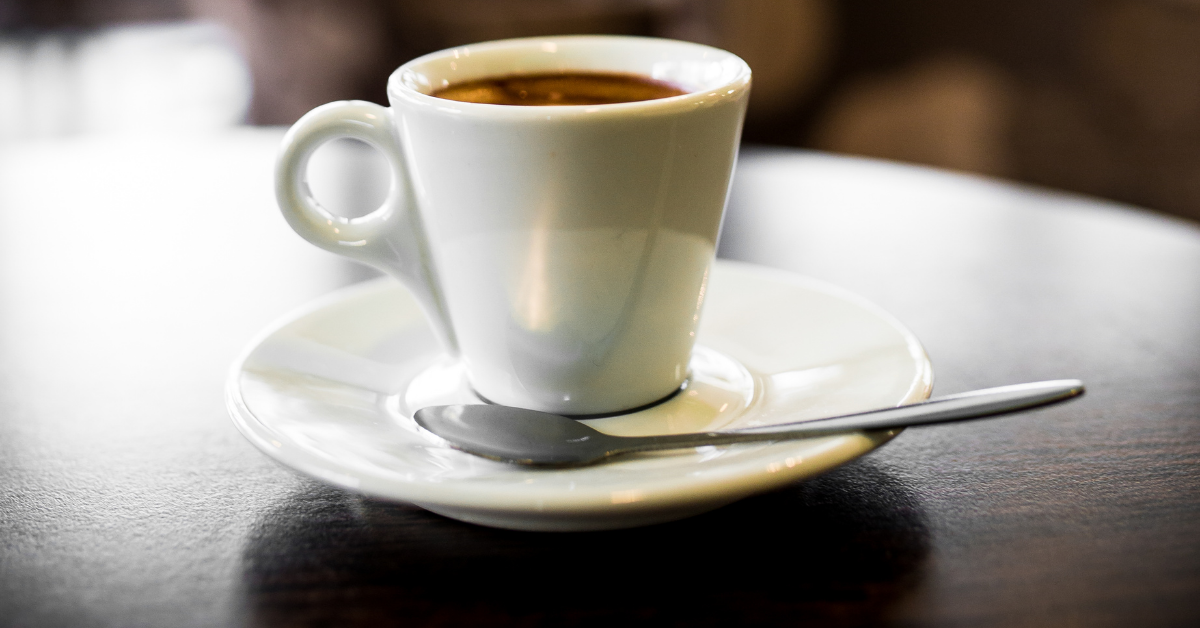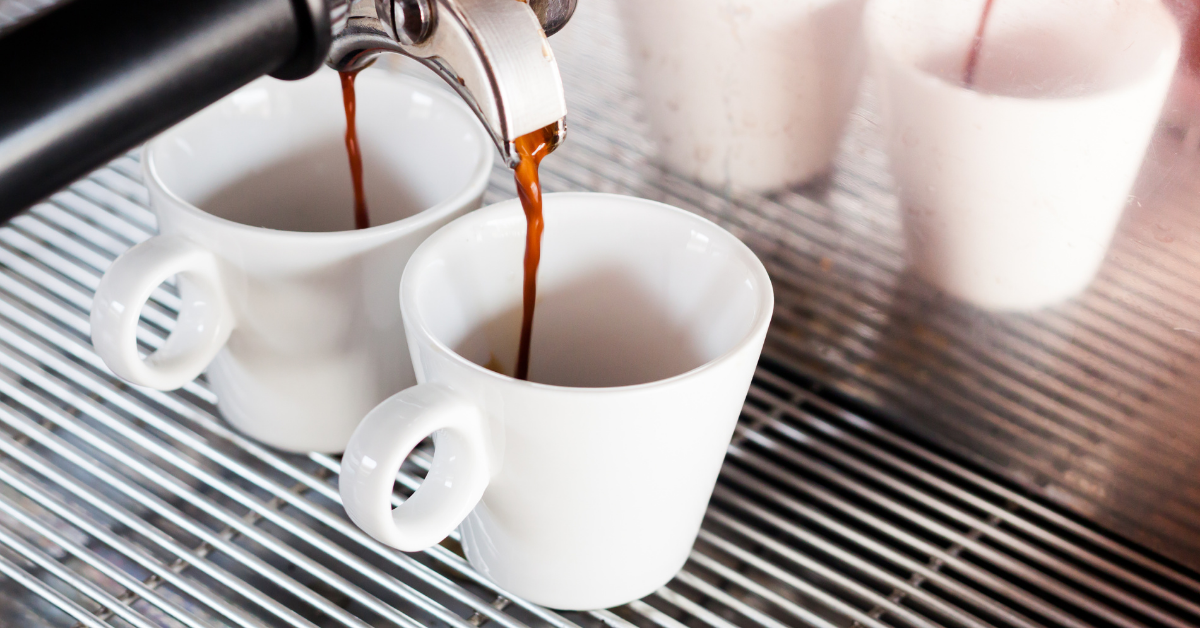If you’re tired of drinking the same ol’ espresso, try ordering a ristretto espresso instead.
Now you might be thinking – aren’t those the same beverage?
Well, not quite. But don’t worry, you’ve come to the right place. In this article, we’ll talk about everything you need to know in order to differentiate these two beverages.
Without further ado, I present to you the battle of the coffee shots – ristretto vs espresso!
What is a Ristretto

The word “ristretto” is Italian for restricted, short. And that’s what pretty much ristretto is – a shorter version of normal espresso.
I know what you’re thinking – why would you drink anything shorter than a shot of coffee?
Well, for flavor, of course!
Ristretto is made with the same amount of coffee as espresso, but with less water.
Usually, pulling the ristretto shot takes between 15 and 20 seconds, which is about 10 seconds shorter than pulling an espresso.
With less water and a shorter brewing time, what you get is a very concentrated shot of coffee that will keep your eyes wide open.
But ristretto isn’t just a stronger espresso shot.
The shorter brewing time means the grounds won’t get extracted all the way. As a result, you get a full-flavored cup that’s sweeter and less bitter than a standard espresso.
How to Make a Ristretto
Does ristretto sound like your type of drink?
You can easily make it at home, as long as you have an espresso machine.
The whole process is practically the same as making an espresso coffee drink. You need to tamp the same amount of coffee beans and apply the same pressure when pulling the shot.
The only difference is that you’ll have to cut the pulling short to no more than 20 seconds. That way, you’ll get that short but sweet shot of ristretto like straight from a cafe.
Here’s how to make it:
- Add 7 to 9 grams of coffee grounds to a portafilter (or multiply by 2 if you’re making a double ristretto shot). Tamp the grounds to a level surface.
- Place the portafilter into the brew head and pull the shot.
- Stop brewing after 15 to 20 seconds.
And that’s all. You should end up with 0.5 to 0.7 ounces of ristretto.
What is an Espresso

Espresso, as you already know, is a full-bodied, concentrated cup of coffee. It’s made by forcing hot water through firmly packed coffee grounds using an espresso maker.
There are no specific beans required for making espresso. You can use the same ones you would for making regular coffee.
But, what is required is the grind size. For a traditional espresso, you need to use finely ground coffee beans, slightly finer than table salt.
Why does it matter, you might ask?
Because espresso machines use pressure to push water through the grounds. If the grounds are too fine, they’ll over-extract. If they’re too coarse, you’ll get a weak coffee.
An espresso shot consists of three distinctive layers.
“Crema” is the golden-brown top foamy layer. Below, we have the “body,” which is the caramelly middle section. Finally, the deep brown “heart” lies at the bottom of the cup.
Each of these layers is responsible for specific qualities of espresso.
Crema mainly consists of coffee oil, so that’s where the bitterness mostly comes from. The body contributes to the fullness and strength of the espresso, while the heart is responsible for the acidity.
How to Make an Espresso
To make espresso at home, you’ll need an espresso maker.
If you own a super-automatic or an automatic machine, brewing is as easy as pressing a button.
With semi-automatic machines, you’ll need to do some steps, like tamping coffee.
Finally, a manual espresso maker requires you to do every step yourself.
Depending on the machine you’re using, you might need to more or less give your input. But the process is pretty much the same in any case.
As for the measurements, a single shot of espresso consists of an ounce of water and 7 to 9 grams of coffee grounds.
Now, let’s make a cup, step by step:
- Fill the portafilter with freshly ground coffee.
- Use the tamper to even the grounds and create a compact disc.
- Place the portafilter into the brew head and pull the shot. If your machine doesn’t end the pull automatically, do it manually after 25 to 30 seconds.
Not all machines give the exact results, so you’ll have to play a bit with your espresso maker until you find out how to make the perfect cup.
Ristretto Vs Espresso: What is the Difference?
Theoretically, these two coffee drinks are practically the same thing but of different sizes. In reality, though, there are enough differences to see them as individual beverages.
Brewing Process

In terms of brewing process steps, they’re pretty much the same. Both ristretto and espresso are made with an espresso maker.
You start with tamping the grounds into the portafilter of your coffee maker and placing it into the brew head. Then, you pull the shot.
In both cases, you’re using the same water pressure as well as temperature. You also use the same amount of grounds.
The only difference lies in the length of the shot. While regular espresso brews for 25 to 30 seconds, ristretto takes only 15 to 20.
Flavor
As you can see, tweaking the brewing time can change the flavor of your espresso drink. That’s because there are hundreds of different compounds in the coffee bean, and they get extracted at different times.
Extraction starts with acids and fats. While acids give coffee that sourness, fats are responsible for the full body of your drink.
Then we have sugars, which, obviously, add sweetness to the cup. And lastly, plant fibers slowly dissolve, causing bitterness in coffee.
Why I am telling you all of this?
Because ristretto and espresso have quite different flavors. While a ristretto is bold and slightly sweet, espresso is more well-rounded and slightly bitter.
And the reason why these coffee beverages taste different lies in different extraction times.
In other words, when you’re making a ristretto, you finish pulling the shot before fibers start dissolving.
Without that bitterness espresso is known for, you can easily sense the sweetness of your coffee.
Strength

Both of these drinks use the same amount of coffee. But because ristretto uses less amount of water, it’s slightly stronger.
The science behind it is simple. The less water you run through the grounds, the more it takes on their flavor. It’s like adding five bags of Kool-aid to a single glass of water.
Now, you might not actually feel like ristretto is a stronger drink. And that’s mainly because it’s naturally sweeter than its big brother, espresso.
As far as caffeine goes, there’s a negligible difference between the two drinks. A longer extraction time means higher caffeine content. That means there’s slightly more caffeine in espresso compared to ristretto.
Speaking in numbers, espresso has about 75 milligrams of caffeine. In the case of ristretto, that number is around 58 for the same amount of liquid.
FAQ
Still on the fence about the differences between these two drinks? In this section, I’ll answer some of the questions you might be wondering.
What Drinks Use Ristretto Shots?
Ristretto is often used in flat white because it adds unique sweetness to microfoam. But in a coffee shop, you can actually order any espresso-based drink made with ristretto instead.
Which Espresso Is the Strongest?
Ristretto coffee is the strongest version of espresso. Compared to other espresso drinks such as regular espresso or lungo, it uses the least amount of water, meaning it’s most concentrated.
Is Short Black the Same as Espresso?
The term short black is used for a basic espresso. It’s made with an ounce of water and 7 to 9 grams of coffee, without any extra water, sugar, or steamed milk added.
Summing Up
If you’re a coffee lover looking for an easy-to-drink, sweet shot of coffee, consider ordering a ristretto. You’ll get your caffeine kick but without any bitterness.
If you do prefer, however, a full range of flavors, then espresso might be a better choice for you. From a slightly longer extraction time, you get a rich, caramelly drink with a slightly bitter aftertaste.
But don’t stop there! Try them both as black as well as a long shot. What’s more, both can serve a base of other drinks like lattes and cappuccinos.










